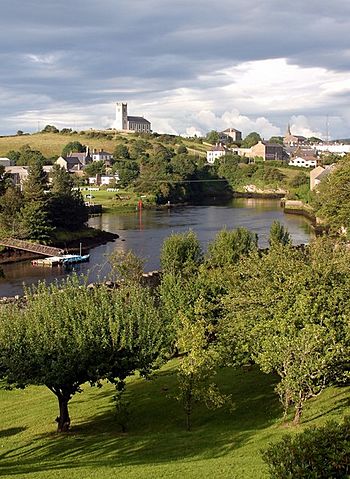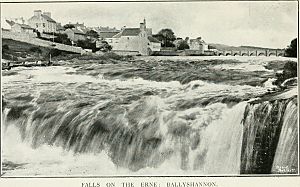River Erne facts for kids
Quick facts for kids River Erne |
|
|---|---|

The River Erne in Ballyshannon
|
|
| Native name | An Éirne |
| Country | Republic of Ireland, Northern Ireland |
| Physical characteristics | |
| Main source | Slieve Glah, County Cavan, Ireland ~255 m (837 ft) |
| River mouth | Atlantic Ocean at Ballyshannon, County Donegal |
| Length | ~129 km (80 mi) |
| Basin features | |
| Basin size | 4,372 km2 (1,688 sq mi) |
| Tributaries |
|
The River Erne ( airn, Irish: Abhainn na hÉirne or An Éirne) in the northwest of the island of Ireland, is the second-longest river in Ulster, flowing through Northern Ireland and the Republic of Ireland, and forming part of their border.
Course
The Erne rises on the east shoulder of Slieve Glah mountain three miles south of Cavan in County Cavan, Republic of Ireland, and flows 80 miles (129 km) through Lough Gowna, Lough Oughter and Upper and Lower Lough Erne, County Fermanagh, Northern Ireland, to the sea at Ballyshannon, County Donegal back in the Republic. For 30 miles from Crossdoney in County Cavan to Enniskillen in County Fermanagh, it is difficult to distinguish the river as it winds its way through interconnected loughs or parts of loughs nestling among the drumlin hills of Cavan and south Fermanagh. The river is 120 kilometres long and is used for fly fishing for trout and salmon, with a number of fisheries along both the river itself and its tributaries. The town of Enniskillen is mostly situated on an island in the river, between Upper and Lower Lough Erne. It is linked to the River Shannon by the Shannon–Erne Waterway.
The total catchment area of the River Erne is 4,372 km2. The long-term average rate of the River Erne is 101.7 cubic metres per second (m3/s)
Name
The river takes its name from a mythical princess named Éirne.
Angling
The building of hydroelectric power stations at Cliff (near Belleek) and Ballyshannon (work began in 1945 and the first power station was commissioned in 1950) caused local salmon beats to be flooded. The run of salmon into the Erne has now declined to a level that is of little angling value, except for the few fish that are occasionally caught below Cliff when the power station is generating. Roach first appeared in the river in 1963, and there was an increase in the roach population in 1968. This increase could well have had an adverse effect on trout stocks, which went into decline at that time. Water pollution became a problem in the 1970s and up to 1987. Since 1987 the pollution problem has been controlled, the roach population has also declined and trout stocks have made a return and provide good angling once more, both on the Erne itself and its tributaries.
Pleasure boating
Live aboard pleasure cruisers are available in several locations along the Erne waterway, including Belturbet, Knockniny, Carrybridge, Bellanaleck, Enniskillen, and Killadeas. In addition to the use of the Erne for live aboard boating holidays, sections of the river are used for water skiing, bank fishing, trolling, jet skiing and scuba diving. Boaters are cautioned, by the Northern Ireland Tourist Board, that Upper Lough Erne is a maze of small islands needing careful navigation, and waves on Lower Lough Erne can reach "open-sea dimensions".
Ancient ruins
The Erne waterway is home to ancient ruins, both Christian and Pagan, with ruins found in several locations, including: Crom Estate, on the North bank of the Upper Erne channel, Gad Island, near Crom Estate, Devenish Island, Inismacsaint Island, Davy’s Island, White Island, and Boa Island. Many of these locations can only be reached by boat.
Devenish Island has a historical display centre adjacent to its ruins. Visitors sometimes use rental boats and the Ordnance Survey of Northern Ireland Activity Map of Lough Erne (ISBN: 978-1-905306-26-8) to locate these ancient sites.
Culture
The song Buachaill Ón Éirne is an Irish ballad about a young boy from the Erne area. It has been recorded by such groups as Clannad and The Corrs.
The Erne is also mentioned in a traditional song, An Mhaighdeán Mhara, which has been recorded by Mairéad Ní Mhaonaigh of Altan, Maighread Ní Dhomhnaill, and Moya Brennan.
Former railway lines
A number of places were once accessible by train along the River Erne, with the once extensive Great Northern Railway and the Sligo, Leitrim and Northern Counties Railway both serving the area.
See also
 In Spanish: Río Erne para niños
In Spanish: Río Erne para niños



